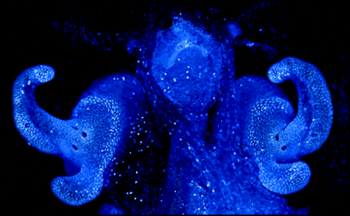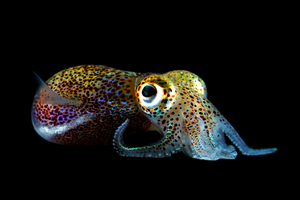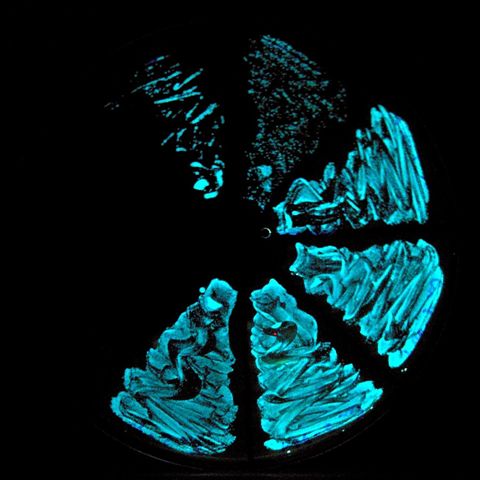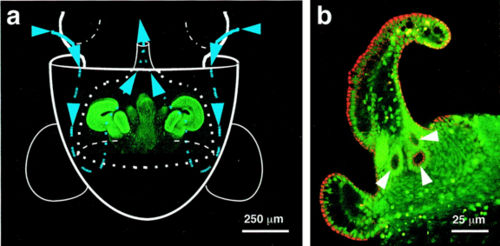Aliivibrio fischeri
Aliivibrio fischeri was discovered in 1889 by Martinus Willem Beijerinck and is a gram-negative bacterium that lives in the oceans of the world. 2007, the species Vibrio fischeri and other species of the genus Vibrio was re- classified and assigned on the basis of genetic data of the genus Aliivibrio. It lives a facultative anaerobe and has flagella, with which it is capable of locomotion. Furthermore, it is bioluminescent and often lives in symbiosis with other organisms. Its genome has been completely sequenced.
Occurrence
A. fischeri occurs in low concentrations in all oceans, but especially common in symbiosis with other marine species such as herring or squid. Using the example of the squid Euprymna scolopes can be a facet of possible symbioses show good: E. scolopes inhabited waters with low depth before Hawaii and hunts at night there. Quickly, he would in the shallow water for prey of robbers, as he would leave a dark, quickly perceptible stain even on the brightly lit by the moon surface. However, by its symbionts it emits light itself and generates a homogeneously illuminated area from which he does not pick up, so almost perfectly camouflaged.
Bioluminescence
A. fischeri has become a model organism for bioluminescence. The bioluminescence is caused by A. fischeri by the catalyzed oxidation of luciferin with luciferase to oxyluciferin. The peak wavelength of the emitted light at 490 nm is the same as the blue -green region of the light spectrum.
Free-living cells, ie, those outside light organs of some symbionts (eg, occurring before the cephalopod Euprymna scolopes Hawaii ) and other outside dense accumulations exist, but do not light up. The decrease is watching on a cell tightly dependent regulation mechanism of the bioluminescence of A. fischeri. To keep the inflammation associated with a bioluminescence energy burden, can this control mechanism to only a bioluminescent activity when the same for the survival of symbionts is also required, so A. fischeri present in light organs. This regulation is made possible by the gene products of the lux operon. This is not only for the synthesis of the encoded proteins necessary for the bioluminescence, but also the information for the production of an enzyme of the autoinducer synthase and a Apoaktivators. In the cytoplasm of the autoinducer synthase is constantly Autoinduktormoleküle constructed which diffuse through the cell wall and into the extracellular fluid. In seawater, they are so diluted that a significant concentration increase is not measurable. But when A. fischeri occurs in a light emitting element in a higher number of cells, the concentration of the Autoinduktormoleküle increases significantly. Since these molecules can relatively easily pass through the cell walls of bacteria, they also get propagated to neighboring cells - which of course also produce Autoinduktormoleküle. Overall, therefore, the concentration of these molecules increases within the cells where they form a connection with the Apoaktivator molecules. This complex occupies the operator of the lux operon and increases the rate of transcription of the following to him genes dramatically: There are on the one hand all the necessary bioluminescence proteins synthesized increasingly, on the other hand, it also comes in a significantly increased transcription and translation of the information on the structure of the autoinducer synthetases and the Apoaktivatoren. This called quorum sensing regulatory mechanism leads to " activation" of bioluminescence in a cell density range of approximately 1010 to 1011 cells / ml - ie concentrations that are detectable in the light organs of squid or fish.
Toxicity
In A. fischeri was also the production of tetrodotoxin (TTX ), a potent neurotoxin, shown. Thus, A. fischeri in olive greens stone crab ( Atergatis floridus ) found, which is a known carrier of this poison.
Use
A. fischeri finds application in the investigation of the water quality. According to EN ISO 11348 waste water samples are mixed with NaCl, then inoculated with a low concentration of luminescent bacteria and measured the light intensity. After 30 min incubation at 15 ° C, the measurement of the light intensity are repeated. The difference in light intensity provides information on the water quality, as the luminescent bacteria adapt their reproduction rate and luminosity of the water quality.



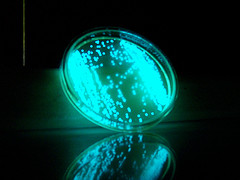
.jpg)
